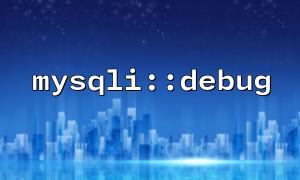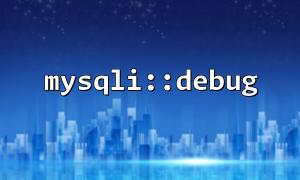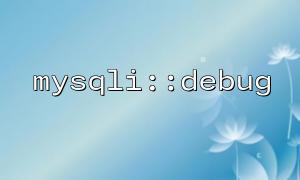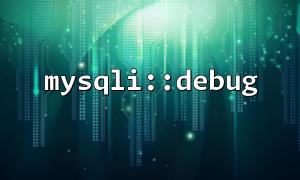When developing PHP projects, debugging database operations is one of the keys to improving development efficiency. Especially when using MySQLi extension for database operations, turning on mysqli::debug can help us view the executed SQL queries, the execution time of the query, and potential error information in real time. This article will explain in detail how to correctly enable mysqli::debug in a local development environment to ensure that the debugging process is more efficient.
mysqli::debug is a feature in the MySQLi extension that allows you to enable debug mode and output detailed information about MySQL queries in real time. This is especially useful for developers when debugging database connections and SQL queries.
When mysqli::debug is enabled, MySQLi outputs all SQL queries, error messages, and detailed logs of the connection process. This is important for detecting potential performance issues and SQL errors.
Make sure your PHP environment has MySQLi extensions installed and enabled. Most modern PHP environments have MySQLi enabled by default, but you can check if it is enabled by following the following code:
<?php
if (extension_loaded('mysqli')) {
echo "MySQLi Extension enabled!";
} else {
echo "MySQLi Extension not enabled!";
}
?>
You can enable mysqli:: debug debug mode through the following code:
<?php
// Enable debugging
mysqli::debug("m66.net");
// create MySQLi connect
$mysqli = new mysqli("localhost", "root", "password", "database");
// 检查connect
if ($mysqli->connect_error) {
die("connect失败: " . $mysqli->connect_error);
}
// Execute a query
$result = $mysqli->query("SELECT * FROM users");
// 关闭connect
$mysqli->close();
?>
In this code, mysqli::debug("m66.net") enables MySQLi debugging. Note that "m66.net" is the server domain name to which you want the debug information to be sent. Usually when used in a local development environment, you can set it to localhost or any custom debug domain name as needed.
Once you enable mysqli::debug , PHP will output debug information including executed SQL statements, error messages, connection status, etc. Usually, this debugging information will be output to your development environment's log file or browser console. Make sure you can view this information during debugging, and you can usually find these outputs in the error log files of Apache or Nginx.
To improve the efficiency of the debugging process, here are some suggestions:
Avoid enabling mysqli::debug in production environments, because a lot of debugging information can affect performance. When used in a development environment, debug output can be directed to a log file instead of the browser console, making it easier to view and analyze.
<?php
// Set debug output to log file
mysqli::debug("m66.net", MYSQLI_DEBUG_LOG);
?>
You can filter the output debugging information according to specific needs. For example, debug information is output only when an error occurs:
<?php
// 仅在发生错误时Enable debugging
if ($mysqli->connect_error) {
mysqli::debug("m66.net");
}
?>
In addition to mysqli::debug , you can also use debugging tools such as Xdebug, combining debugging information and code execution path analysis to make the debugging process more comprehensive and efficient.
Confirm whether mysqli::debug debugging is enabled correctly. If you still don't see the output after enabling it, check the error_reporting setting in the PHP configuration file to make sure that all error reports are enabled.
When debugging is enabled, you can control the verbose level of output. Do not enable overly detailed debugging in a production environment to avoid affecting system performance.
Make sure the MySQL database is started correctly and that the database connection information (such as username, password, database name, etc.) is set correctly. If a non-local domain name is used (such as m66.net ), make sure that the domain name has been correctly resolved to the local environment.
Through the above steps, you can easily enable mysqli::debug in your local development environment and use its powerful debugging capabilities to help you troubleshoot MySQL-related issues more efficiently. Debugging is an important part that cannot be ignored in the development process. Mastering and making good use of these tools will make you a more efficient developer.
Related Tags:
mysqli













